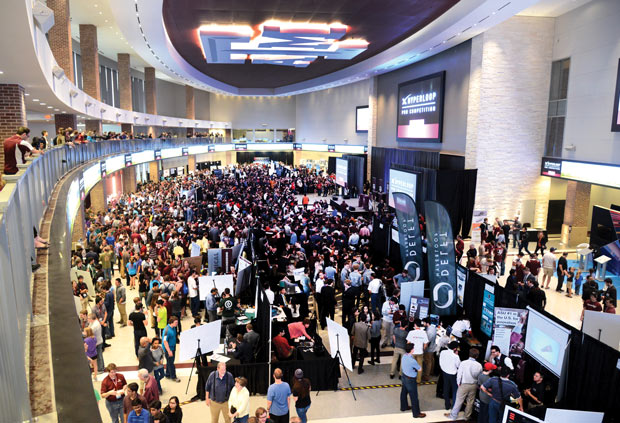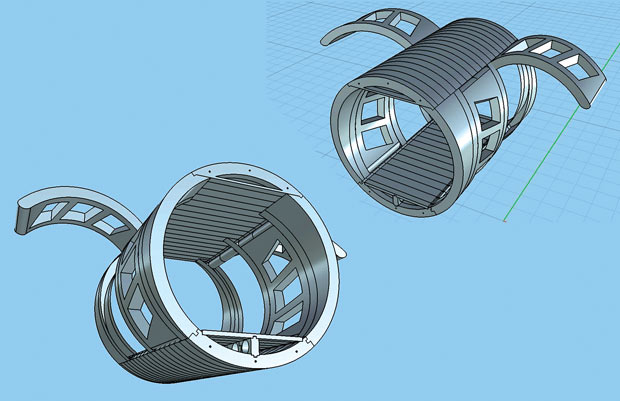
Wing doors are featured in one of Hyperloop Transportation Technologies’ capsule designs. Images courtesy of Hyperloop Transportation Technologies.
Latest News
March 1, 2016
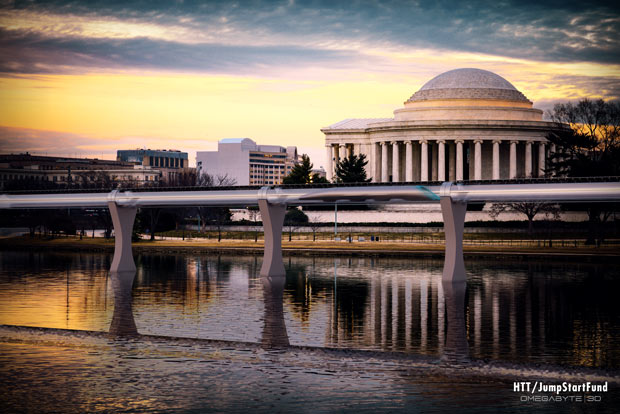 A mock-up of what Hyperloop Transportation Technologies’ Hyperloop might look like in the U.S. capital. Image courtesy of Hyperloop Transportation Technologies.
A mock-up of what Hyperloop Transportation Technologies’ Hyperloop might look like in the U.S. capital. Image courtesy of Hyperloop Transportation Technologies.When Elon Musk, of SpaceX and Tesla fame, first released his 57-page manifesto for the futuristic “Hyperloop Alpha” in 2013, no one dismissed him as delusional, but plenty questioned whether the tube-based, high-speed transportation system would ever see the light of day.
In only three years, some serious groundwork has been laid to transform the Jetsons-like Hyperloop dream into a reality of the modern landscape. A pair of startups, each with different business models and Hyperloop design strategies, are building and testing critical components of the system and breaking ground on physical test tracks this year. Musk, who released his ideas to the open-source community declined, at the time, to spearhead Hyperloop development. However, he recently hired the construction giant Aecom to build a Hyperloop test track to host winners of a SpaceX-sponsored pod design competition later this summer.
Across the country, student and professional design teams are gearing up for the Hyperloop race. Hyperloop Transportation Technologies (HTT), one of a pair of commercialized players in this space, is fostering an open-source community working on the design problem while forging relationships with UCLA architecture and urban planning students to throttle up its Hyperloop design efforts. Chief rival Hyperloop Technologies (HTI) is an active sponsor of the SpaceX pod design competition, ponying up $150,000 in prize money and a summer internship for the winner of the competition, held this January at Texas A&M University. Many universities, including UCLA and Purdue, are offering Hyperloop design classes as part of their engineering curricula.
While we’re not there yet, this momentum is finally making the decades-old pipe dream of a supersonic tube transportation system a reality more so than ever before, according to Sandeep Sovani, director of Global Automotive Industry for ANSYS, whose simulation software is in the forefront of Hyperloop development with both commercial ventures as well as with the competition teams. “When Elon Musk published that white paper, it launched the Hyperloop into public attention given his stature,” says Sovani, who has personally been actively involved in Hyperloop development prior to joining ANSYS. “This is the transportation technology of the future, and a significant amount of progress has been made.”A lot of that progress is thanks to the widespread use of simulation software—everything from FEA (finite element analysis) to CFD (computational fluid dynamics) and specialized optimization and analysis tools. Simulation has provided a much-needed means to iterate and test designs for levitation systems and pod capsules that pose key aerodynamic challenges that have never before been proven, Sovani says. In addition, the large-scale infrastructure such as the pylons and track systems that will serve as the foundation for the Hyperloop need to be put through its paces to test structural integrity along with the ability to withstand vibrations and earthquakes—all design challenges that can be effectively explored with simulation.
“There are so many different parameters and design integrations that need to be tested—the ability to do it virtually is what makes it possible,” Sovani says. “It would be too cost prohibitive to do it all with physical prototypes.”
Space-Age Travel
The concept for tube transportation has been around for decades, but Musk advanced the idea with his vision of a pneumatic, tube-based transportation system that could transport people at speeds as fast as 750 mph—significantly faster than air travel. His idea, initially conceived as an alternative to a high-speed rail system connecting San Francisco and Los Angeles, calls for a network of elevated, reduced pressure tubes (for reducing drag) that transport aerodynamically designed pods using a levitation or air system that’s driven by linear induction motors and air compressors. While the tubes are relatively low-tech, there’s far more complexity in other parts of the Hyperloop system design, from the space-age pods and propulsion systems to the levitation mechanisms that create an air cushion on which the pods ride.
 Wing doors are featured in one of Hyperloop Transportation Technologies’ capsule designs. Images courtesy of Hyperloop Transportation Technologies.
Wing doors are featured in one of Hyperloop Transportation Technologies’ capsule designs. Images courtesy of Hyperloop Transportation Technologies.There’s room to innovate and differentiate on the basic concept and that’s where the two commercial ventures are focusing their efforts. HTI, which has catapulted from a few person garage startup in 2014 to 80-plus people in a facility in Los Angeles, including 65 engineers, envisions its Hyperloop as a next-generation transport for both people and cargo, according to Josh Geigel, vice president of Design and Analysis. Its Hyperloop design encompasses four main components: an ultra-lower pressure tube environment; a compressor that sucks in air instead of displacing it; a levitation system built on air bearings or maglev; and electronic propulsion.
A veritable “who’s who” of simulation and optimization tools, including Fluent CFD, the full ANSYS suite, CD-adapco STAR-CCM+ CFD, Red Cedar’s HEEDS, MATLAB and a number of magnetic analysis tools are pushing the HTI Hyperloop effort along. The tools, Geigel says, are instrumental in helping the HTI team iterate design concepts faster while narrowing down the field so it can focus on the optimal results. “Simulation gives us a starting point to optimize and increase performance or reduce costs,” he explains. “We know what the Hyperloop would cost now if we were to build it. We know moving forward, we have to get that cost even more competitive. Optimization, coupled with simulation, helps us target the low-hanging fruit on which to spend research dollars and will enable us to reduce the cost with a novel design.”
Simulation, for example, is helping the team ensure that the low-pressure environment inside the tube can withstand safety standards and it will also ensure the team doesn’t over-design and spend excessive money on unnecessary steel. A free CFD simulation tool out of Stanford is helping with airflow optimization while multidisciplinary simulation is tackling problems like the proper placement of magnet arrays or the acceleration for the propulsion mechanisms, Geigel says.
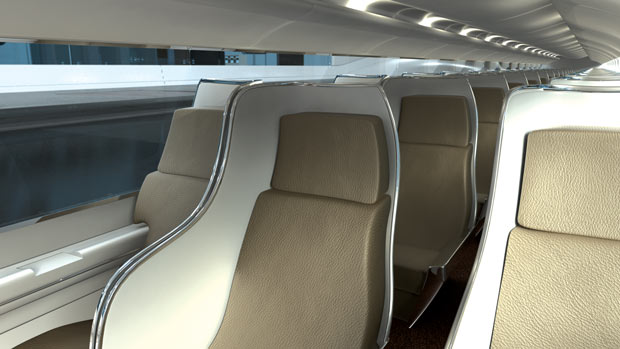 In keeping with its emphasis on crowdsourcing, Hyperloop Transportation Technologies has enlisted UCLA architecture and urban planning students to design the Hyperloop passenger experience. Image courtesy of Hyperloop Transportation Technologies.
In keeping with its emphasis on crowdsourcing, Hyperloop Transportation Technologies has enlisted UCLA architecture and urban planning students to design the Hyperloop passenger experience. Image courtesy of Hyperloop Transportation Technologies.For all of the simulation work, physical prototyping is still critical for this kind of large-scale, never-before-been-seen venture, Geigel says. This quarter, HTI plans to send an electric motor along a one kilometer track at speeds over 300 miles per hour (something it calls its Propulsion Open Air Test) and will follow up late this year or early in 2017 with its “Kitty Hawk moment,” when it showcases the performance a full system, Geigel says. “Even the greatest simulation only gets you close—eventually you have to go out there and test something,” he says. “It’s especially important for a project that’s going to exist in the real world.”
HTT, which started its initiative back in 2013, has its roots in a non-profit incubator funded by NASA, which created a platform called JumpStartFund intended to help entrepreneurs leverage the collective power of community to build companies around their innovations and ideas. Dirk Ahborn, founder of the platform, lobbied to put the Hyperloop concept on the platform and from there, the company was born.
Today, HTT is evolving its Hyperloop design with a core team of 500 people in addition to a community of 20,000 people. Yet there’s a twist on HTT’s model: Much of the core team, made up of marketers, engineers, social media people and others of varying backgrounds, devotes a minimum of 10 hours a week to the company and is paid stock options in return. It’s not quite an open source development model, Ahborn maintains, because the company is building up its own valuable IP (intellectual property) while putting the best and brightest minds on the project. “We’ve got an aerospace engineer who worked on the Mars Rover, someone else involved in the Manhattan Project and people working at Boeing, Tesla, SpaceX and Faraday Future,” Ahborn says. “Sometimes it’s difficult to convince superstars to let everything go and come to a startup, but they are available for 10 hours a week and sometimes, that’s all that’s needed.”
Along with its novel development model, HTT is leveraging scrum development principles and the usual litany of design tools—Autodesk virtual prototyping suite, collaboration platforms and a variety of simulation packages, including the xFlow next-generation CFD package—to iterate designs in the virtual world before building costly prototypes. “We’re simulating a lot of different elements, from safety to airflow within the capsule to the most important part of the capsule—geometry,” Ahborn says.
HTT has also made a lot progress on physical prototypes. The company has partnered to build a five-mile track in Quay Valley, CA, as part of a planned eco-community, and is scheduled to break ground in 2016 for public opening by 2018. The company also enlisted UCLA architecture and urban design graduate students to work on the pod and station design as well as how transportation options to and from Hyperloop stations would integrate into total user experience.
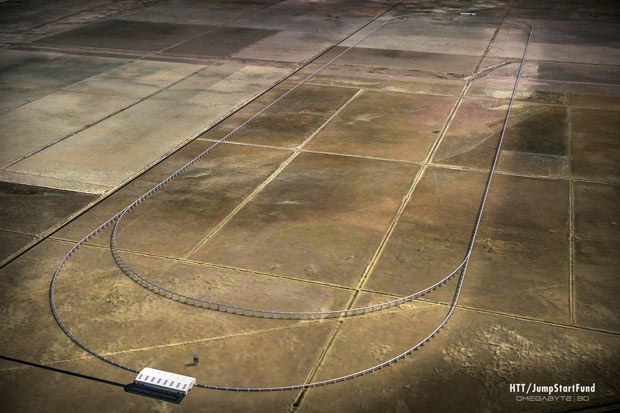 Mid-year is the target date for Hyperloop Transportation Technologies to start construction on its test track in Quay Valley, a planned solar-powered community between Los Angeles and San Francisco. Image courtesy of Hyperloop Transportation Technologies.
Mid-year is the target date for Hyperloop Transportation Technologies to start construction on its test track in Quay Valley, a planned solar-powered community between Los Angeles and San Francisco. Image courtesy of Hyperloop Transportation Technologies.“What we’ve done from the beginning is to build a movement,” Ahborn says. “When we started out, people looked at us and said this isn’t possible,’ and ‘it can’t be done.’ Now people don’t doubt it can be done—it’s just a matter of time.”
Subscribe to our FREE magazine, FREE email newsletters or both!
Latest News
About the Author
Beth Stackpole is a contributing editor to Digital Engineering. Send e-mail about this article to [email protected].
Follow DERelated Topics







